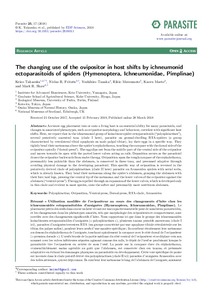The changing use of the ovipositor in host shifts by ichneumonid ectoparasitoids of spiders (Hymenoptera, Ichneumonidae, Pimplinae)
Takasuka K; Fritzen NR; Tanaka Y; Matsumoto R; Maeto K; Shaw MR
The changing use of the ovipositor in host shifts by ichneumonid ectoparasitoids of spiders (Hymenoptera, Ichneumonidae, Pimplinae)
Takasuka K
Fritzen NR
Tanaka Y
Matsumoto R
Maeto K
Shaw MR
EDP SCIENCES S A
Julkaisun pysyvä osoite on:
https://urn.fi/URN:NBN:fi-fe2021042719051
https://urn.fi/URN:NBN:fi-fe2021042719051
Tiivistelmä
Accurate egg placement into or onto a living host is an essential ability for many parasitoids, and changes in associated phenotypes, such as ovipositor morphology and behaviour, correlate with significant host shifts. Here, we report that in the ichneumonid group of koinobiont spider-ectoparasitoids ("polysphinctines"), several putatively ancestral taxa (clade I here), parasitic on ground-dwelling RTA-spiders (a group characterised by retrolateral tibial apophysis on male palpal tibiae), lay their eggs in a specific way. They tightly bend their metasoma above the spider's cephalothorax, touching the carapace with the dorsal side of the ovipositor apically ("dorsal-press"). The egg slips out from the middle part of the ventral side of the ovipositor and moves towards its apex with the parted lower valves acting as rails. Deposition occurs as the parasitoid draws the ovipositor backwards from under the egg. Oviposition upon the tough carapace of the cephalothorax, presumably less palatable than the abdomen, is conserved in these taxa, and presumed adaptive through avoiding physical damage to the developing parasitoid. This specific way of oviposition is reversed in the putatively derived clade of polysphinctines (clade II here) parasitic on Araneoidea spiders with aerial webs, which is already known. They bend their metasoma along the spider's abdomen, grasping the abdomen with their fore/mid legs, pressing the ventral tip of the metasoma and the lower valves of the ovipositor against the abdomen ("ventral-press"). The egg is expelled through an expansion of the lower valves, which is developed only in this clade and evident in most species, onto the softer and presumably more nutritious abdomen.
Kokoelmat
- Rinnakkaistallenteet [27094]
